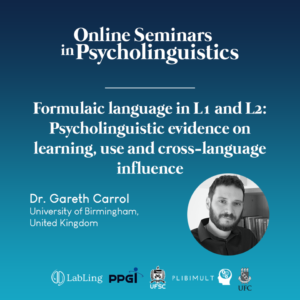Formulaic Language in L1 and L2: Psycholinguistic evidence on learning, use and cross-language influence
Data da publicação: 23 de setembro de 2020 Categoria: Eventos, Notícias, Palestras Watch Live on
Watch Live on
Thursday, September 24, 1 pm (Brasilia time)
Formulaic Language in L1 and L2: Psycholinguistic evidence on learning, use and cross-language influence
Gareth Carrol
University of Birmingham, UK
Formulaic language covers the range of multiword sequences (idioms, collocations, etc.) that form an important part of language competency. Research in how these sequences are learned and used by first (L1) and second (L2) speakers has gathered pace in recent years. In this talk I will review evidence that focuses on three questions: how first and second language users process formulaic language in real time; how languages interact during processing in the L2; and how language users learn new multiword expressions. The talk will focus on results from a range of experiments that help to demonstrate how we can research these questions, as well as what the results tell us about the underlying mechanisms.
Bio:
Gareth Carrol is a Senior Lecturer in psycholinguistics at the University of Birmingham, UK. His research looks at how language users understand idioms and other types of figurative phrase, such as conventional metaphors. This work has focused on the factors that influence processing and comprehension in native and non-native speakers, including aspects such as familiarity, transparency and context. He is also interested in formulaic language more generally, and have conducted several studies to explore the processing of a range of formulaic phrases such as collocations and binomials, where word choice is restricted or highly conventionalised. His work uses experimental techniques such as eye-tracking, reaction times and offline techniques (ratings and speaker judgements) to build a detailed picture of how language users process language at the multiword level.

